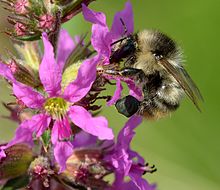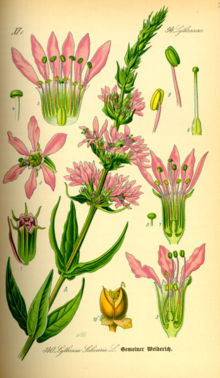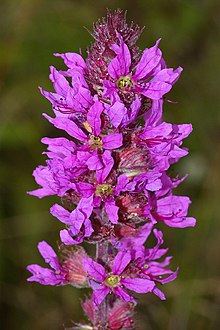Common loosestrife
| Common loosestrife | ||||||||||||
|---|---|---|---|---|---|---|---|---|---|---|---|---|

Common loosestrife ( Lythrum salicaria ) |
||||||||||||
| Systematics | ||||||||||||
|
||||||||||||
| Scientific name | ||||||||||||
| Lythrum salicaria | ||||||||||||
| L. |
The Ordinary loosestrife ( Lythrum salicaria ) is a plant of the genus Lythrum ( Lythrum ) within the family of Lythraceae (Lythraceae).
description


Vegetative characteristics
The common loosestrife is a perennial , herbaceous plant that reaches heights of up to 2 meters and a width of 1.5 meters. Up to 50 upright, partly branched, hairy, square to polygonal stems can grow out of the rhizome . The purple loosestrife is helomorphic , submerged shoots develop a ventilation tissue ( aerenchyma ) that supplies the rhizome with oxygen.
The sitting (sessile) leaves are arranged in threefold whorls or opposite, further up alternately on the stems. The leaf blade is narrow-lanceolate to oval. The following leaves have a rounded to heart-shaped base; the nerves stand out clearly below.
Generative characteristics
The flowering period extends from June to September. Each spike or grape-shaped inflorescence can contain a hundred or more flowers; these false ears are purple.
The hermaphroditic flowers have a double flower envelope . There is a tubular, double-toothed axle cup. The six or five free petals are more than 1 inch long.
The structure of the flowers is trimorphic heterostyly : There are three different types of flowers (on different plant specimens):
- Flowers with long pistils and medium- long and short stamens
- Flowers with medium-length styles and long and short stamens
- Flowers with short pistils and long and medium-length stamens
The pollen of the long-stalked stamens is green and large, and the others are yellow and smaller.
The two-lobed capsule fruit pops open when ripe.
The number of chromosomes is 2n = 60, less often 30.
ecology
In the common purple loosestrife, the persistence buds are on the surface of the earth; it is a hemicryptophyte .
Cross-pollination is ensured by the fact that the scars of the long styles have the longest, those of the short ones the shortest scar papillae. Charles Darwin already showed that out of 18 possible combinations only 6 lead to full seed production (“legitimate pollination”). The legitimate pollination is seven times more successful than the "illegitimate". "Legitimate" pollination is when the pollen-supplying anthers of one flower are at the same height as the stigmas of the other flower.
Flower visitors are mainly hoverflies , but also bees and butterflies . Purple loosestrife is a nectar donor of particular value. It is also an important food plant for the caterpillars from the genus of the night peacock butterfly ( Saturnia ).
A single plant specimen can produce up to three million seeds that are spread by wind and water . The seeds are equipped with mucous hairs and easily adhere to waterfowl, which they spread in this way. They germinate in almost all sufficiently moist soils next spring.
Occurrence
The common purple loosestrife is Eurasian - suboceanic , especially in Eurasia and Australia. In North America it is an introduced neophyte (see below).
Common loosestrife grows frequently in damp locations and is widespread in reed beds and swamps , on the banks of lakes and ponds, rivers, streams and canals and in ditches. It prefers the lower altitudes and is somewhat warmth-loving, but also occurs in middle mountain regions . The locations are primarily wet or alternately humid, temporarily flooded, nutrient-rich, swamp humus soils , for example Gley . It is a weak character species of the Filipendulion association in Central Europe, but also occurs in other societies of the Molinietalia order, the Phragmitetea class or the Agropyro-Rumicion association.
Ingredients and use
Purple loosestrife contains the glycoside salicarin , pectins , resins, essential oil , plenty of tannins and the flavone vitexin .
In times of need the young shoots, leaves and the white base were eaten as vegetables. Due to its high tannin content between 9% (roots) and 14% (flowers), leather was tanned with purple loosestrife as early as the 16th century. It was also used to impregnate wood and rope to prevent rapid rot in the water.
The purple loosestrife was used as a medicinal plant in ancient times. According to Pliny , purple loosestrife was used against eczema . Dioscurides recommended it against blood spitting and dysentery . Flowers and rhizome of the purple loosestrife are used as remedies. Folk medicine uses it for diarrhea, blood flow and dysentery. To do this, 1 to 3 grams of roots are boiled with two liters of water.
Purple loosestrife was used, for example, during the cholera epidemic in the 19th century. Due to the tannins, the plant has strong astringent, bactericidal, hemostatic and diuretic properties. The fact that the purple loosestrife was used as a hemostatic agent probably gave it its name (or the color of its flowers). The red dye used to be used to color sugar.
In a study on the diet of the Mediterranean rural population, it was found that the plant has a protective effect against diabetes (type 2).
Use as an ornamental plant
The common loosestrife is widely used as an ornamental plant for water fringes. It has been in culture since 1596 at the latest. There are numerous varieties.
Purple loosestrife as a neophyte in North America
In North America, since its introduction by humans in the 19th century, the common loosestrife has had the reputation of being a pesky "weed". Once introduced as a medicinal and attractive garden plant, this species spread rapidly. In areas where purple loosestrife stocks are expanding, they can affect the flow rate of rivers and canals. However, there is no evidence that the purple loosestrife is displacing native species. 29 North American species use the common loosestrife, and there are many reports that purple loosestrife is being outcompeted by native North American species. A study at 41 locations in Ontario showed that there was no significant difference in the species richness of vascular plants, regardless of whether purple loosestrife was present or not, not even with increasing population density of purple loosestrife.
However, the purple loosestrife is controlled in North America. The release of insect pests that have specialized in purple loosestrife (including the weevil Hylobius transversovittatus and the leaf beetle species Galerucella calmariensis and Galerucella pusilla ) has proven to be a successful measure .
Sources and further information
Individual evidence
- ↑ a b Lythrum salicaria L., common purple loosestrife. In: FloraWeb.de.
- ↑ a b Ruprecht Düll , Herfried Kutzelnigg : Pocket dictionary of the plants of Germany and neighboring countries. The most common Central European species in portrait . 7th, corrected and enlarged edition. Quelle & Meyer, Wiebelsheim 2011, ISBN 978-3-494-01424-1 , p. 485 .
- ↑ a b Ruprecht Düll , Herfried Kutzelnigg : Pocket dictionary of the plants of Germany and neighboring countries. The most common Central European species in portrait . 7th, corrected and enlarged edition. Quelle & Meyer, Wiebelsheim 2011, ISBN 978-3-494-01424-1 , p. 486 .
- ↑ a b Erich Oberdorfer : Plant-sociological excursion flora for Germany and neighboring areas . With the collaboration of Angelika Schwabe and Theo Müller. 8th, heavily revised and expanded edition. Eugen Ulmer, Stuttgart (Hohenheim) 2001, ISBN 3-8001-3131-5 , pp. 681 .
- ↑ James A. Duke: Handbook of phytochemical constituents of GRAS herbs and other economic plants. CRC Press, Boca Raton FL. 1992.
- ↑ see Madaus, textbook on biological remedies
- ^ The Local Food-Nutraceuticals Consortium: Understanding local Mediterranean diets: A multidisciplinary pharmacological and ethnobotanical approach. In: Pharmacological Research . Volume 52, 2005, pp. 353–366, online (PDF file; 944 kB).
- ^ Eckehart J. Jäger, Friedrich Ebel, Peter Hanelt, Gerd K. Müller (eds.): Rothmaler Exkursionsflora von Deutschland. Volume 5: Herbaceous ornamental and useful plants. Spectrum Academic Publishing House, Berlin and Heidelberg 2008, ISBN 978-3-8274-0918-8 .
- ^ David I. Theodoropoulos: Invasion Biology: Critique of a pseudoscience. Avvar Books, Blythe, California, 2003, pp. 37-38.
- ↑ Bernd Blossey: Purple Loosestrife. invasiveplants.net, 2002 ( Memento from October 28, 2014 in the Internet Archive ). A report on the spread and control of the purple loosestrife in the United States.
literature
- Ruprecht Düll , Herfried Kutzelnigg : Pocket dictionary of plants in Germany and neighboring countries. The most common Central European species in portrait. 7th, corrected and enlarged edition. Quelle & Meyer, Wiebelsheim 2011, ISBN 978-3-494-01424-1 .
- Henning Haeupler , Thomas Muer: picture atlas of the fern and flowering plants of Germany (= the fern and flowering plants of Germany. Volume 2). Published by the Federal Agency for Nature Conservation. Ulmer, Stuttgart 2000, ISBN 3-8001-3364-4 .
- Gerhard Madaus : Textbook of biological remedies volume 1. Medicinal plants. G. Thieme, Leipzig 1938; Olms, Hildesheim 1979, ISBN 3-487-05890-1 : Electronic version of the 1935 edition ( Memento of November 6, 2013 in the Internet Archive ).
- Erich Oberdorfer : Plant-sociological excursion flora. 6th edition. Ulmer Verlag, Stuttgart 1990, ISBN 3-8001-3454-3 .
- Elfrune Wendelberger: Plants of the wetlands - bodies of water, moors, floodplains. Book guild Gutenberg, Munich 1986, ISBN 3-7632-3265-6 (or: BLV-Verlag, ISBN 3-405-12967-2 ).
Web links
- Profile and distribution map for Bavaria . In: Botanical Information Hub of Bavaria .
- Common loosestrife . In: BiolFlor, the database of biological-ecological characteristics of the flora of Germany.
- Lythrum salicaria L. In: Info Flora , the national data and information center for Swiss flora . Retrieved December 28, 2015.
- Distribution in the northern hemisphere according to Eric Hultén
- Thomas Meyer: Data sheet with identification key and photos at Flora-de: Flora von Deutschland (old name of the website: Flowers in Swabia )
- Biology and Biological Control of Purple Loosestrife . (with detailed references)
- Data sheet from Dr. Duke's Phytochemical and Ethnobotanical Databases .
- More pictures: [1] [2] [3] [4] [5]




